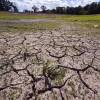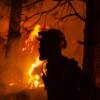State and local fire officials told Massachusetts lawmakers on Tuesday that more frequent summer drought conditions are leading to more persistent wildfires, and they called on the state to provide more funding to help them battle those blazes.
Several fire officials testified that while wildfires are common in Massachusetts in the spring, they used to be rare in the summer. On average, the state sees fewer than 50 wildfires the entire month of August. This year, the state recorded more than 100 wildfires during that month. And since the beginning of June, 450 wildfires burned 449 acres in the state, according to David Celino, chief fire warden for the state Department of Conservation and Recreation.
"When I drove out to Rockport and Gloucester, in these conditions, it looked like Arizona," Celino told members of the Joint Committee on COVID-19 and Emergency Preparedness and Management in a virtual hearing Tuesday afternoon. "Everything was browned out because of the drought conditions in late July, when everything should have been lush green. So that contributed extensively to that fire behavior."
In August, those fires included nearly 90 acres burned in Lynn Woods, about 75 acres in Breakheart Reservation Forest in Saugus, and roughly 20 acres in Rockport.
"We seem to be having these flash drought events about every other season, starting in 2014, 16, 18, 20 and 22," Celino said. "And so whether that's a pattern or not that we can count on, it's hard to say. But it shows the trend."
"An extended drought period leaves vegetation drier, more flammable and more prone to fires that burn wider and deeper," State Fire Marshal Peter Ostroskey testified. "It also reduces the static water sources we use to fight those fires: the lakes, ponds and streams that we draft from in areas without municipal water."
Celino explained the dry conditions cause fires to burn more deeply in the ground, making them harder to fully extinguish.
"As we respond, if we have a fire that gets away from us, we can't get on it right away, you can now expect that these things are going to burn 10 to 15 inches [deep into the ground] and we're not going to be done with them in an hour and a half and get back to watching the Patriots game," Celino said. "We're going to be there for days or weeks on end. ... And this becomes an increased risk to firefighter safety and a capacity stress on resources."
A third of fire departments in the state are staffed by volunteers or part time, on-call firefighters, Ostroskey said, noting it's hard to ask volunteers to dedicate the time and effort required to fight such labor-intensive blazes.
"Those are people who are leaving their jobs, leaving their families at the ring of that bell and typically are very low [pay], if compensated at all," he explained.
Sterling Fire Chief David Hurlbut, who is the statewide fire mobilization chief, pointed to the example of a brush fire the Ashby fire department fought in August.
"They basically ate up their entire budget for the year, the whole fiscal year, on an incident that took about a week," Hurlbut said. "And then other departments, they may break equipment through mobilizing to other communities."
And, he said, there's inadequate funding to cover those expenses. MEMA acting Director Dawn Brantley called on the lawmakers on the committee to address those budget concerns.
"If I could get you guys to hear anything, and walk forward with that, that would be that these folks are absolutely heroic in these responses," Brantley said. "But those localities are eating all of those costs each time."
She added most wildfires don't raise to the level of a federal or state disaster declaration.
"So these responses are all going to be self-funded," she said. "And that is is going to continue to be a burden for both state agencies, but also our our local partners who are absolutely critical."







